Senate Commerce Science And Transportation Committee
-
- INLAND FINANCE: But I Don’t Need That Much Marine News, May 2019 #32
When enough to meet the need is not enough to get the help.
From my office window in downtown St. Louis, I can see a dramatic illustration of the inefficiency in how our country moves freight. My office faces east, and I look down on a stretch of Interstate 70, that major east-west highway that runs from Baltimore to Interstate 15 in Utah. It is not unusual to see the traffic on this highway heavily congested, even at a standstill at times. This congested traffic usually includes many tractor-trailer trucks. While some of these trucks might be there to cover the proverbial last-mile for a delivery to a local destination, I feel reasonably certain that, given the nature of this highway, most of them are just passing through, on their way from a remote origin to an equally remote destination.
But just beyond Interstate 70 to the east, as viewed from my perch on the 38th floor, is another highway, where the traffic is never congested and is typically moving steadily. I am referring, of course, to the Mississippi River, which is part of what the U.S. Department of Transportation has designated Marine Highway M-55. As I look down on this contrast in traffic conditions on these two highways, it occurs to me to wonder if maybe, just maybe, some of that freight that is sitting at a standstill on the asphalt highway couldn’t be carried just as well on the aquatic one. It would also seem likely to save a great deal of fuel, and to avoid a fair amount of exhaust emissions.As explained on the website of the U.S. Maritime Administration (MarAd), this is in fact the mission of the Marine Highway Program, namely, “to expand the use of our Nation’s navigable waterways to relieve landside congestion, reduce air emissions, provide new transportation options, and generate other public benefits by increasing the efficiency of the surface transportation system.” It is such considerations as these that have led to proposals to carry containers on barges, or to build special-purpose vessels specifically designed for such use, or to move freight off of the highways and on to the waterways in other ways.
Your Mode: only as good as the one that precedes or follows it
But there is one critically important thing that the highways and the waterways have in common: you have to be able to get on them and get off of them. The highways have their access ramps and exit ramps. On the inland waterways, these points of access and egress are the many ports and terminals that make the 12,000 commercially navigable miles of the inland and intra-coastal waterways an actual system for freight transportation.
The ports and terminals do much more than just get cargo on to, and off of, the inland waterways. They are the also where cargo moves to and from all of the modes of carriage – water, road, and rail. To and from the truck; to and from the railcar; to and from the barge. They are where the gears of our nation’s freight transportation system meet and mesh. Every river channel could be dredged clean and clear, and every lock and dam could be made like new, and it would matter little if cargo could not get to and from the river and the other modes that make up our total transportation network, through the ports and terminals.In this regard, the value of our nation’s large coastal seaports is being increasingly recognized. Recent legislation, for example, has finally redirected the substantial amounts that have accumulated in the Harbor Maintenance Trust Fund back to their originally intended purpose.
However, the needs of the many, often relatively small, ports and terminals on the inland waterways continue to be overlooked. For example, in the Consolidated Appropriations Act of 2019, which ended the most recent government shutdown, $200 million was appropriated for the Port Infrastructure Development Program that is administered by MarAd. However, as passed, the bill specifies that “projects eligible for funding provided under this heading shall be projects for coastal seaports” (Division F, Title I; emphasis added). For the Marine Highways Program, under which smaller inland ports and terminals would be eligible to receive assistance, only $7 million was appropriated out of the total appropriations to MarAd of almost $1 billion.
Addressing the Imbalance
Presently there are only limited funding opportunities that make inland port infrastructure and inland ports of entry eligible for funding at all, and only a small amount of total funding from those programs typically fund port-type projects. This is the case with BUILD (Better Utilizing Investments to Leverage Development, formerly TIGER) and the INFRA (Infrastructure for Rebuilding America) programs. As a practical matter, inland ports and terminals cannot compete effectively for funding against large highway or bridge projects, and often cannot even meet the $5 million project minimum required by current programs. Somewhat ironically, infrastructure projects of inland ports and terminal facilities cannot obtain funding because they are less costly than the minimum required for those programs.Efforts are being made in the direction of addressing this imbalance. In October 2018, Senator Tom Carper (D-DE), Ranking Member on the Senate Environment and Public Works Committee, introduced a bill, S.3587, to allow greater amounts to be granted for ports, railways, and intermodal hubs. Specifically, the bill aims to amend the Nationally Significant Freight and Highway Projects Program – which was created as part of Fixing America’s Surface Transportation Act (FAST Act) and under which MarAd awards FASTLANE grants – by removing the cap on INFRA grants to multimodal freight projects. However, Senator Carper’s bill would still leave in place the $5 million project minimum requirement.
The silver lining may be that at least Congress has appropriated $200 million for port infrastructure development and that an effort is being made to expand the amount available for grants to ports and intermodal hubs.
In July 2018 Senator Roger Wicker (R-MS) introduced a bill, the “Port Operations, Research, and Technology (PORT) Act” (S. 3273), to create a port-related infrastructure grants program to build on the Port Infrastructure Development Program administered by MarAd. This bill specified a $1 million project minimum requirement. Although the bill was reported favorably out of the Senate Commerce, Science, and Transportation Committee in August 2018, it was not voted on by the end of the 115th Congress.
For the current 116th Congress, Senator Wicker is the Chair of the Senate Commerce, Science, and Transportation Committee, so he is in a position to advance his earlier bill. His bill is an authorization bill, not an appropriations bill, so if his bill is eventually enacted into law, it will provide a basis for Congress to provide funding for an expanded Port Infrastructure Development Program, including eligibility for “small” projects that need “only” $1 million.
“Small” is in the eye of the beholder. What might seem “small” from the perspective of Congress seeking to support the nation’s freight transportation system as a whole could well be a major contribution to the capital expansion plans or operational needs of a local port or terminal on the inland waterways. But these “small” ports and terminals are the gatekeepers of that larger system. A chain is only as strong as its weakest link. Meeting the needs of the ports and terminals on the inland waterways – however “small” they might appear to be when viewed individually – will have a highly leveraged effect in maintaining and enhancing the efficiency of our nation’s freight transportation system overall.
At least one inland waterways industry association with which I am familiar, Inland Rivers, Ports, and Terminals, Inc. (IRPT), is encouraging its members to contact their Congressional delegations to urge the introduction of a new standalone discretionary program dedicated to inland ports and terminal projects. However, this is an opportunity for all members of the inland waterways industry to call the attention of our lawmakers to this need.
We know that every elected representative values knowing what is important to his or her constituents. Grant amounts might be “small” in the context of an appropriations bill, but for an elected representative there is no vote that is too small. Many members of Congress provide for their constituents to communicate with them on their official websites, by email, or on social media. If those whom we elect do not hear from us about this need, we have no one to blame but ourselves.
James A. Kearns has represented owners, operators, financial institutions and end users for more than 30 years in the purchase, construction and financing of vessels engaged in both foreign and coastwise trades of the United States. Kearns has earned an LL.M. (in Taxation) from New York University, J.D. cum laude from the University of Notre Dame, and a B.S.E.E., summa cum laude from the University of Notre Dame.
This article first appeared in the May 2019 print edition of MarineNews magazine.
-
- THE BARGE AND TOWING INDUSTRY: A LEGISLATIVE REVIEW Maritime Reporter, Mar 1986 #50
sworn into office in 1985 with perhaps its primary challenge to control the spiralling federal deficit. Members of the House of Representatives and Senate, both Democrats and Republicans, and the President, expressed their strong commitment to decrease government spending without raising taxes. This
-
- As Interest in LNG Surges, Regulators Struggle to Keep Pace Maritime Reporter, Dec 2014 #20
. The U.S. cannot make strides in LNG regulation without Congress playing a significant role. The House Transportation and Infrastructure Committee and the Senate Commerce, Science and Transportation Committee should take the lead on developing legislation to fill the regulatory and policy gaps discussed above
-
- A Full Agenda for the International Container Trades Maritime Logistics Professional, May/Jun 2017 #10
CGM. UASC through merging with Hapag Lloyd will be subsumed into the OCEAN Alliance. On the Hill Both the U.S. House of Representatives and the U.S. Senate have been actively involved with shipping matters this year. As requested by House and Senate leaders, I participated in several rounds of discussions
-
- 100% Container Scanning in Ports: It is Possible Maritime Logistics Professional, Q1 2013 #34
(WMD) prior to loading. Objections by trading partners surfaced and were confirmed by the Government Accounting Office (GAO). In her testimony before the Senate Commerce, Science and Transportation Committee, DHS Secretary Janet Napolitano said in part, “DHS has learned a great deal from these pilots, but it
-
 )
March 2024 - Marine Technology Reporter page: 37
)
March 2024 - Marine Technology Reporter page: 37miscible barrier ? uid heavier than seawater (sg=1.026) and lighter than the battery electrolyte (sg=1.265). The original cell vent cap was screwed into the top of the riser pipe to vent the gases associated with charging. Wires were soldered to the lead (Pb) posts. The lead-acid battery was additionall
-
 )
March 2024 - Marine Technology Reporter page: 15
)
March 2024 - Marine Technology Reporter page: 15sensor options for longer mission periods. About the Author For glider users working in ? sheries and conservation, Shea Quinn is the Product Line Manager the Sentinel can run several high-energy passive and active of the Slocum Glider at Teledyne Webb acoustic sensors, on-board processing, and imaging
-
 )
March 2024 - Marine Technology Reporter page: 6
)
March 2024 - Marine Technology Reporter page: 6MTR Editorial Advisors Gallaudet Hardy The Honorable Tim Gallaudet, Kevin Hardy is President PhD, Rear Admiral, U.S. of Global Ocean Design, Navy (ret) is the CEO of creating components and Ocean STL Consulting and subsystems for unmanned host of The American Blue vehicles, following a career
-
 )
April 2024 - Maritime Reporter and Engineering News page: 43
)
April 2024 - Maritime Reporter and Engineering News page: 43“The industry is an ecosystem which includes owners, managers, mariners, shipyards, equipment makers, designers, research institutes and class societies: all of them are crucial,” – Eero Lehtovaara, Head of Regulatory & Public Affairs, ABB Marine & Ports All images courtesy ABB Marine and Ports provi
-
 )
April 2024 - Maritime Reporter and Engineering News page: 35
)
April 2024 - Maritime Reporter and Engineering News page: 35SIMULATION e have a close relationship with tech- Realism is prized beyond immersive, photo-realistic visu- nology, evidenced by, for example, als, and providers are introducing increasingly accurate func- the phones we are estimated to un- tionality. FORCE Technology’s upcoming DEN-Mark2 math- lock around
-
 )
April 2024 - Maritime Reporter and Engineering News page: 27
)
April 2024 - Maritime Reporter and Engineering News page: 27RADM PHILIP SOBECK, MILITARY SEALIFT COMMAND With COVID, we had to make some hard choices for our Do your CIVMARs have upward mobility? mariners because we couldn’t rotate. Many of our mariners The Navy has Sailors who become “Mustangs,” and work found other employment, and were able to use their skills
-
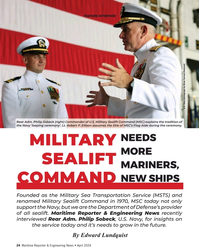 )
April 2024 - Maritime Reporter and Engineering News page: 24
)
April 2024 - Maritime Reporter and Engineering News page: 24FEATURE INTERVIEW U.S. Navy photograph by Brian Suriani/Released Rear Adm. Philip Sobeck (right) Commander of U.S. Military Sealift Command (MSC) explains the tradition of the Navy ‘looping ceremony’. Lt. Robert P. Ellison assumes the title of MSC’s Flag Aide during the ceremony. NEEDS MILITARY MORE
-
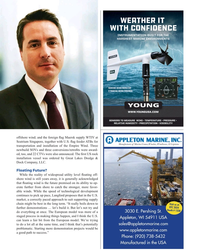 )
April 2024 - Maritime Reporter and Engineering News page: 23
)
April 2024 - Maritime Reporter and Engineering News page: 23offshore wind; and the foreign ? ag Maersk supply WTIV at Seatrium Singapore, together with U.S. ? ag feeder ATBs for transportation and installation of the Empire Wind. Three newbuild SOVs and three conversions/retro? ts were award- ed, too, and 22 CTVs were also announced. The ? rst US rock installa
-
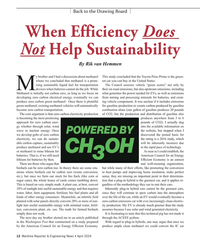 )
April 2024 - Maritime Reporter and Engineering News page: 12
)
April 2024 - Maritime Reporter and Engineering News page: 12Back to the Drawing Board When Efficiency Does Not Help Sustainability By Rik van Hemmen y brother and I had a discussion about methanol This study concluded that the Toyota Prius Prime is the green- where we concluded that methanol is a prom- est car you can buy in the United States. ising sustainable
-
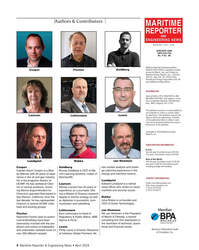 )
April 2024 - Maritime Reporter and Engineering News page: 4
)
April 2024 - Maritime Reporter and Engineering News page: 4Authors & Contributors MARITIME REPORTER AND ENGINEERING NEWS M A R I N E L I N K . C O M ISSN-0025-3448 USPS-016-750 No. 4 Vol. 86 Maritime Reporter/Engineering News (ISSN # 0025-3448) is published monthly Cooper Fischer Goldberg except for March, July, and October by Maritime Activity Reports, Inc.
-
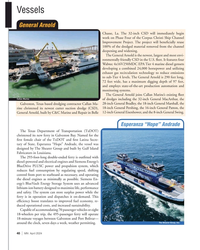 )
April 2024 - Marine News page: 40
)
April 2024 - Marine News page: 40Vessels General Arnold Chasse, La. The 32-inch CSD will immediately begin work on Phase Four of the Corpus Christi Ship Channel Improvement Project. The project will bene? cially reuse 100% of the dredged material removed from the channel deepening and widening. The General Arnold is the newest,
-
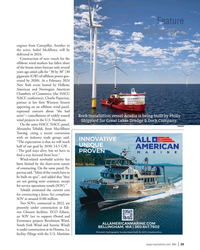 )
April 2024 - Marine News page: 29
)
April 2024 - Marine News page: 29engines from Caterpillar. Another in the series, Isabel McAllister, will be delivered in 2024. Construction of new vessels for the offshore wind markets has fallen short of the boom times forecast only several years ago amid calls for “30 by 30” (30 gigawatts (GW) of offshore power gen- erated by
-
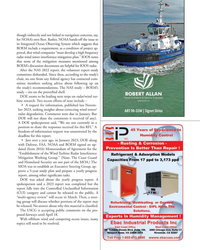 )
April 2024 - Marine News page: 25
)
April 2024 - Marine News page: 25though indirectly and not linked to navigation concerns, say, for NOAA’s own ? eet. Rather, NOAA hands-off the issue to its Integrated Ocean Observing System which suggests that BOEM include a requirement, as a condition of project ap- proval, that wind companies “must develop a high frequency radar
-
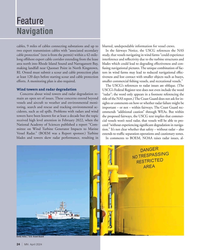 )
April 2024 - Marine News page: 24
)
April 2024 - Marine News page: 24Feature Navigation cables, 9 miles of cables connecting substations and up to blurred, undependable information for vessel crews. two export transmission cables with “associated secondary In the fairways Notice, the USCG references the NAS cable protection” (text is from the permit) within a 42-mile-
-
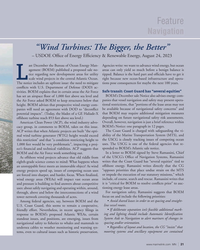 )
April 2024 - Marine News page: 21
)
April 2024 - Marine News page: 21Feature Navigation “Wind Turbines: The Bigger, the Better” – USDOE Of? ce of Energy Ef? ciency & Renewable Energy, August 24, 2023 ast December the Bureau of Ocean Energy Man- Agencies write: we want to advance wind energy, but ocean agement (BOEM) published a proposed sale no- areas can only yield so
-
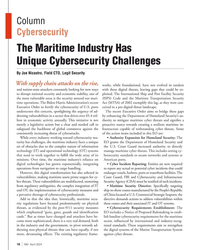 )
April 2024 - Marine News page: 18
)
April 2024 - Marine News page: 18Column Cybersecurity The Maritime Industry Has Unique Cybersecurity Challenges By Joe Nicastro, Field CTO, Legit Security With supply chain attacks on the rise, works, while foundational, have not evolved in tandem and nation-state attackers constantly looking for new ways with these digital threats
-
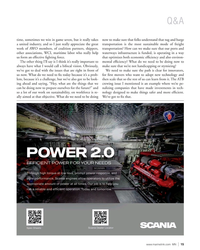 )
April 2024 - Marine News page: 15
)
April 2024 - Marine News page: 15Q&A time, sometimes we win in game seven, but it really takes now to make sure that folks understand that tug and barge a united industry, and so I just really appreciate the great transportation is the most sustainable mode of freight work of AWO members, of coalition partners, shippers, transportation?
-
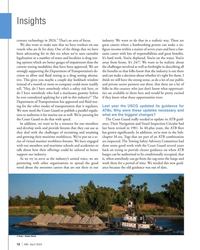 )
April 2024 - Marine News page: 12
)
April 2024 - Marine News page: 12Insights century technology in 2024.” That’s an area of focus. industry. We want to do that in a realistic way. These are We also want to make sure that we have workers on our great careers where a hardworking person can make a six- vessels who are ? t for duty. One of the things that we have ? gure
-
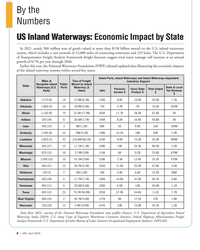 )
April 2024 - Marine News page: 8
)
April 2024 - Marine News page: 8By the Numbers US Inland Waterways: Economic Impact by State In 2021, nearly 500 million tons of goods valued at more than $158 billion moved on the U.S. inland waterways system, which includes a vast network of 12,000 miles of connecting waterways and 219 locks. The U.S. Department of Transportation
-
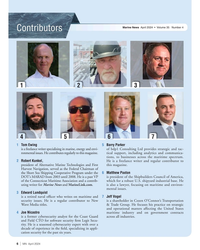 )
April 2024 - Marine News page: 6
)
April 2024 - Marine News page: 6Marine News April 2024 • Volume 35 Number 4 Contributors 1 2 3 5 4 6 7 1 Tom Ewing 5 Barry Parker is a freelance writer specializing in marine, energy and envi- of bdp1 Consulting Ltd provides strategic and tac- ronmental issues. He contributes regularly to this magazine. tical support, including
-
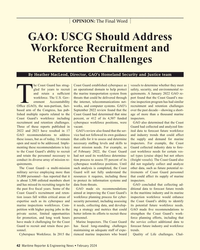 )
February 2024 - Maritime Reporter and Engineering News page: 42
)
February 2024 - Maritime Reporter and Engineering News page: 42OPINION: The Final Word GAO: USCG Should Address Workforce Recruitment and Retention Challenges By Heather MacLeod, Director, GAO’s Homeland Security and Justice team he Coast Guard has strug- Coast Guard established cyberspace as vessels to determine whether they meet gled for years to recruit an
-
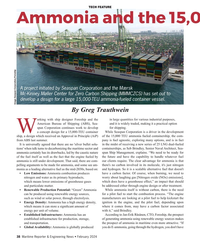 )
February 2024 - Maritime Reporter and Engineering News page: 38
)
February 2024 - Maritime Reporter and Engineering News page: 38TECH FEATURE Ammonia and the 15,00 A project initiated by Seaspan Corporation and the Mærsk Mc-Kinney Møller Center for Zero Carbon Shipping (MMMCZCS) has set out to develop a design for a large 15,000-TEU ammonia-fueled container vessel. Image Seaspan Corporation/Foreship By Greg Trauthwein orking with
-
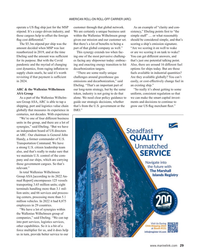 )
February 2024 - Maritime Reporter and Engineering News page: 29
)
February 2024 - Maritime Reporter and Engineering News page: 29AMERICAN ROLL-ON ROLL-OFF CARRIER (ARC) operate a US ? ag ship just for the MSP customer through that global network. As an example of “clarity and con- stipend. It’s a cargo driven industry, and We are certainly a unique business unit sistency,” Ebeling points ? rst to “the those cargoes help to
-
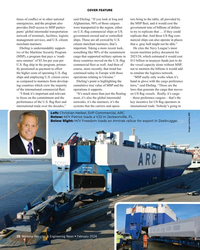 )
February 2024 - Maritime Reporter and Engineering News page: 28
)
February 2024 - Maritime Reporter and Engineering News page: 28COVER FEATURE times of con? ict or in other national said Ebeling. “If you look at Iraq and tors bring to the table, all provided by emergencies, and the program also Afghanistan, 98% of those cargoes the MSP ? eet, and it would cost the provides DoD access to MSP partici- were transported to the
